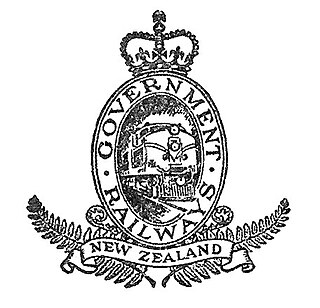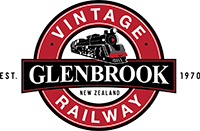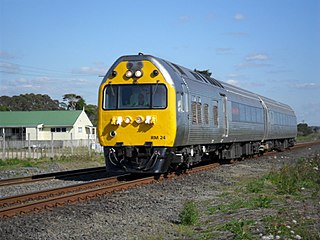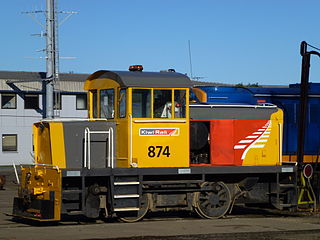
Railway preservation in New Zealand is the preservation of historically significant facets of New Zealand's rail transport history. The earliest recorded preservation attempt took place in 1925, although the movement itself did not start properly until 1960.

The New Zealand F class was the first important class of steam locomotive built to operate on New Zealand's railway network after the national gauge of 3 ft 6 in was adopted. The first locomotives built for the new gauge railways were two E class double Fairlies for the Dunedin and Port Chalmers Railway Company. The F class was the first class ordered by the central government, and between 1872 and 1888, a total of eighty-eight members of the class were constructed.

The NZR A class of 1873 consisted of three types of steam locomotives used on New Zealand's railway network of similar specification but differing detail. The first and most numerous were from the Dübs and Company, the next from the Wellington firm E.W. Mills Lion Foundry, and the last from the Scottish firm of Shanks. The specifications are for the Dubs Yorkshire engines.
Locomotives of New Zealand is a complete list of all locomotive classes that operate or have operated in New Zealand's railway network. It does not include locomotives used on bush tramways.

The NZR WAB class locomotives were steam locomotives designed, built and used by New Zealand Railways Department (NZR). Their wheel arrangement is described by the Whyte notation 4-6-4T. The locomotives were designed by NZR chief draughtsman S.H. Jenkinson as tank versions of the AB class 4-6-2 Pacific locomotive. Initially, the locomotives were separated into two classes, designated WAB for mainline work and WS for suburban work.

The New Zealand Railways Department, NZR or NZGR and often known as the "Railways", was a government department charged with owning and maintaining New Zealand's railway infrastructure and operating the railway system. The Department was created in 1880 and was corporatised on 1 April 1982 into the New Zealand Railways Corporation. Originally, railway construction and operation took place under the auspices of the former provincial governments and some private railways, before all of the provincial operations came under the central Public Works Department. The role of operating the rail network was subsequently separated from that of the network's construction. From 1895 to 1993 there was a responsible Minister, the Minister of Railways. He was often also the Minister of Public Works.

The Glenbrook Vintage Railway (GVR) is a heritage steam railway in Glenbrook, New Zealand.
This is a list of jargon commonly used by railfans and railway employees in New Zealand.

The New Zealand DA class locomotive were a class of diesel-electric mainline locomotives operated on the New Zealand railway system between 1955 and 1989. Consisting of 146 locomotives, it was the most numerous class to ever operate in New Zealand, with five more than the AB class steam locomotive.

The New Zealand DSC class locomotive is a heavy shunting locomotive used throughout New Zealand. The class was built in seven batches, the first 18 locomotives being built by British Thomson-Houston of the United Kingdom, with the remainder being built by New Zealand Railways (NZR).

The RM class was the classification used by the New Zealand Railways Department (NZR) and its successors gave to most railcars and railbuses that have operated on New Zealand's national rail network. "RM" stands for Rail Motor which was the common name at the turn of the 20th century for what became known in New Zealand as railcars. As many types of railcars are operated, class names have been given to each railcar type to differentiate them from others.

NZR D class steam tank locomotives operated on New Zealand's national railway network. The first entered service in 1874 all had been withdrawn by the end of 1927, which allowed the D classification to be used again in 1929.
This list collects the transport-related vehicles exhibited or owned by the Museum of Transport and Technology (MOTAT) in Auckland, New Zealand.

The New Zealand TR class locomotive is a type of diesel shunting locomotives built by many different manufacturers. Defined as "shunting tractors" or "rail tractors" by KiwiRail and its predecessors, they are classified "TR" for tractor as a result. Many of these locomotives have been withdrawn, but some are still in service. The first locomotive of this class was built by NZR in 1924. The most powerful were Japanese-built Hitachi TRs, with 138 kW Cummins engines.

Steam Incorporated, often abbreviated to Steam Inc., is a railway heritage and preservation society based at the Paekākāriki railway station, Paekākāriki at the southern end of the Kāpiti Coast, approximately 50 minutes north of Wellington on the west coast of New Zealand's North Island. Unlike some societies who operate on preserved sections of closed branch lines, Steam Incorporated owns a depot beside one of the country's most important railway lines, the North Island Main Trunk railway, and restores heritage locomotives and rolling stock for use on excursions on the regular national rail network.
The NZR DS class locomotive is a type of 16 diesel shunting locomotives built by the Vulcan Foundry and supplied by the Drewry Car Co from 1949–1955, for New Zealand Railways (NZR).

The Waitara Railway Preservation Society is a society established in 1999 to operate a heritage railway over the former Waitara Industrial Line railway that operated between Lepperton and Waitara in the New Plymouth District of New Zealand's North Island. The line had been closed that year after 124 years of operation, after the closure of the local AFFCO freezing works in the town.

The NZR FA class was a class of tank steam locomotives that was built as a larger version of the NZR F class 0-6-0T. The requirements were for larger water and coal capacity on a locomotive that could handle grades better than the F class. Due to costs involved in producing new machines, NZR chose to rebuild existing machines with larger coal and water capacity, larger boiler and firebox, higher boiler pressure and larger diameter pistons. Seven F class engines were rebuilt between 1892 and 1897. Another seven were built new, one at Newmarket Workshops in 1896 and six at Addington Workshops in 1902–03.

The Mountain Rimu Timber Company owned and operated a bush tramway near Mamaku, south of the Kaimai Range near Rotorua in the Bay of Plenty Region of the North Island of New Zealand. The tramway, with a track gauge of 3+1⁄2 feet (1,067 mm), was used from approximately 1898, to at least 1935.
The Matahina Tramway was a bush tramway in the eastern Bay of Plenty region of New Zealand, connecting to the East Coast Main Trunk at Edgecumbe and terminating at Matahina, near Waiohau. It was initially owned by Matahina Tramways Limited, which in turn was part-owned by Matahina Forests Limited and the other users of the tramway. Matahina Forests were the owners of the Whakatane Board Mill (WBM). The tramway operated as an extension of the Whakatane Board Mills Line from Awakeri to the Whakatane Board Mill near Whakatane, until its closure in 1966.


















